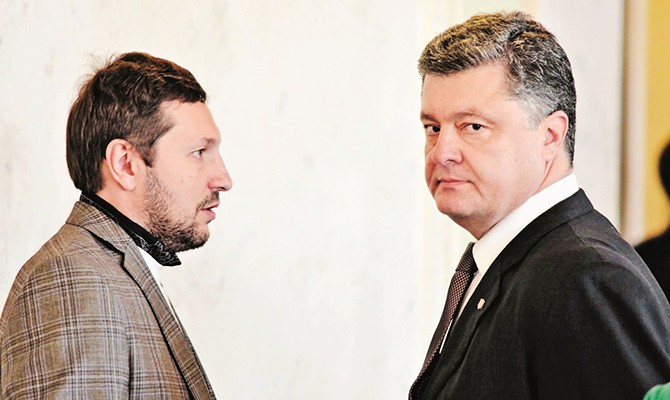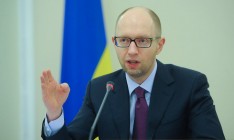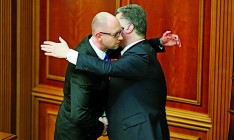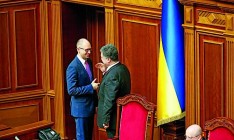Politics
threatMinistry of Information Policy to get involved in issues of war and propaganda

The Ministry of Information Policy, which existed during the premiership of Pavlo Lazarenko, will be revived in the new government. The initiators of the revival explain the appearance of the new agency by an external threat, but their critics fear internal problems caused by the activities of the ministry.
Experience of the National Guard
A new ministry will appear in the government – the Ministry of Information Policy. President Petro Poroshenko announced its creation on Monday night at the meeting of the Petro Poroshenko Bloc faction. “The president simply said that there will be a ministry of information, which came as a surprise to many deputies and experts. Moreover, he did not say why such a ministry is needed,” a source in the PPB faction told Capital. At the same meeting, the deputies voted for the appointment of MP Yuriy Stets, who for a long time was a member of the Supervisory Board of Channel 5 and also headed the Solidarnist party, which was renamed into the Petro Poroshenko Bloc, to head the ministry. In addition to that, Poroshenko and PPB faction leader Yuriy Lutsenko are godfathers of Stets’ daughter.
In a conversation with Capital, Stets said the idea of creating the ministry appeared right after the creation of the Information Security Department under the National Guard of Ukraine in June 2014 (he headed this department prior to the elections). He says that the new agency will be involved in the realization of the common program of information security, including providing the population with reliable information from primary sources. In addition, its tasks will include formation of Ukraine’s image, counteraction to information aggression on the part of Russia and prevention of external influence on Ukraine’s internal information space.
“This is a collective idea that appeared back in 2007. I think that if it had been realized earlier we would not have lost the informational and ideological war in the east and in Crimea,” he said. Stets says the existence of the Information Security Department under the National Guard provided good experience and allowed to renew broadcasting in the ATO zone. In particular, 42 series of the information publication Ukraina Yedyna (United Ukraine) with a total print run of 500,000 have been distributed.
Noteworthy, in the Common Register of Mass Media the publication is registered to Stets’ spouse – Yana Konotop, a journalist of Channel 5. According to Stets, the publication is printed from his personal money and with the help of volunteers. Noteworthy, in the official declaration he declared an income of slightly over half a million hryvnia last year.
Workload for one department
The information about creation of the new ministry caused a wave of protests in the media community and representatives of the PPB were also disenchanted. For instance, former journalist Serhiy Leshchenko even initiated a protest in front of the Verkhovna Rada with a demand to abandon the idea of the new structure in the government.
Director of the Media Law Institute Taras Shevchenko told Capital that at the moment there is no need to create such a ministry, because the existing State Committee and National Council for TV and Radio Broadcasting (NCTRB) have the power and competence to conduct and realize the state information policy. He said that no democratic state has a ministry of information. “Despite the statements on counter-propaganda, the ministry will influence the content and manipulate editorials anyway,” he predicts.
Chairman of the Board of NGO Telekrytyka Natalia Ligachyova believes that the goal of counter-propaganda and provision of information to residents of the Donbas region announced by the ministry’s initiators can be achieved by the work of one department of the State TV and Radio Broadcasting Committee (STRBC). “For the tasks announced by Stets it would sufficient to make a quality product and not create a full-fledged ministry and positions in it,” she told Capital.
Yesterday, STRBC Chair Oleh Nalyvaiko could not find time to speak with Capital, explaining that he had a very long meeting. Noteworthy, there has been an example in the history of independent Ukraine, when the ministry of information was created to suit the needs of a specific individual. In 1996, the government of Pavlo Lazarenko put the STRBC under the control of the newly created ministry, which was abolished in 1999 by then Premier Viktor Yushchenko. Throughout the whole period of the existence of the Information Ministry, the late Zinoviy Kulyk was its only head.






 of the agreement of syndication with Financial Times Limited are strictly prohibited. Use of materials which refers to France-Presse, Reuters, Interfax-Ukraine, Ukrainian News, UNIAN agencies is strictly prohibited. Materials marked
of the agreement of syndication with Financial Times Limited are strictly prohibited. Use of materials which refers to France-Presse, Reuters, Interfax-Ukraine, Ukrainian News, UNIAN agencies is strictly prohibited. Materials marked  are published as advertisements.
are published as advertisements.